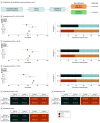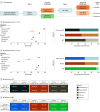Conflict of Interest Disclosures: Dr Salvadó reported grants from European Union’s Horizon 2020 Research and Innovation Program under Marie Skłodowska-Curie action, Alzheimer’s Association Research Fellowship, Brightfocus Foundation, Alzheimerfonden, Greta och Johan Kocks, and Strategic Research Area MultiPark (Multidisciplinary Research in Parkinson’s Disease) during the conduct of the study as well as personal fees from Springer, Adium, Biogen, and GE Healthcare outside the submitted work. Dr Janelidze reported grants from Swedish Alzheimer Foundation outside the submitted work. Dr Therriault reported personal fees from Alzheon and Neurotorium outside the submitted work. Dr Mattsson-Carlgren reported personal fees from Eli Lilly, Merck, and Biogen outside the submitted work. Dr Palmqvist reported research support (paid to institution) from Avid and ki:elements through Alzheimer’s Drug Discovery Foundation. In the past 3 years, he has received consultancy and/or speaker fees from BioArtic, Biogen, Eisai, Eli Lilly, Novo Nordisk, and Roche. Dr Teunissen reported grants from the European Commission, Innovative Medicines Initiatives 3TR, the European UnionJoint Programme–Neurodegenerative Disease Research, European Partnership on Metrology, cofinanced from the European Union’s Horizon Europe Research and Innovation Programme and by the Participating States, Horizon Europe, CANTATE project funded by the Alzheimer Drug Discovery Foundation, Alzheimer Association, Michael J Fox Foundation, Health~Holland, Dutch Research Council, Alzheimer Drug Discovery Foundation, and Selfridges Group Foundation; is a recipient of ABOARD, which is a public-private partnership receiving funding from ZonMW and Health~Holland, Topsector Life Sciences & Health and of TAP-dementia, a ZonMw funded project in the context of the Dutch National Dementia Strategy; has research contracts with Acumen, ADx Neurosciences, AC-Immune, Alamar, Aribio, Axon Neurosciences, Beckman-Coulter, BioConnect, Bioorchestra, Brainstorm Therapeutics, C2N diagnostics, Celgene, Cognition Therapeutics, EIP Pharma, Eisai, Eli Lilly, Fujirebio, Instant Nano Biosensors, Merck, Muna, Novo Nordisk, Olink, PeopleBio, Quanterix, Roche, Toyama, Vaccinex, Vivoryon; serves as editor in chief of Alzheimer Research and Therapy and on editorial boards of Molecular Neurodegeneration, Alzheimer’s & Dementia, Neurology: Neuroimmunology & Neuroinflammation, Medidact Neurologie/Springer, and is a committee member to define guidelines for cognitive disturbances and acute neurology in the Netherlands; and has consultancy or speaker contracts for Aribio, Biogen, Beckman-Coulter, Cognition Therapeutics, Eisai, Eli Lilly, Merck, Novo Nordisk, Novartis, Olink, Roche, Sanofi, and Veravas. Dr van der Flier reported grants from ZonMW, Dutch Research Council, European Union Joint Programme–Neurodegenerative Disease Research, European Union Innovative Health Initiative, Alzheimer Nederland, Hersenstichting CardioVascular Onderzoek Nederland, Health~Holland, Topsector Life Sciences & Health, stichting Dioraphte, Noaber Foundation, Pieter Houbolt Fonds, Gieskes-Strijbis fonds, stichting Equilibrio, Edwin Bouw fonds, Pasman stichting, Philips, Biogen, Novartis-NL, Life-MI, Avid, Roche, Eli Lilly–NL, Fujifilm, Eisai, and Combinostics and is a recipient of ABOARD, which is a public-private partnership receiving funding from ZonMW, Health~Holland, Topsector Life Sciences & Health; TAP-dementia, receiving funding from ZonMw, Avid Radiopharmaceuticals, Roche, and Amprion; Innovative Health Initiative–PROMINENT and Innovative Health Initiative–AD-RIDDLE, which are supported by the Innovative Health Initiative Joint Undertaking, the European Union’s Horizon Europe research and innovation programme and COCIR, European Federation of Pharmaceutical Industries and Associations, EuropaBio, MedTech Europe, and Vaccines Europe, with Davos Alzheimer’s Collaborative, Combinostics Oy, C2N Diagnostics, and neotiv during the conduct of the study (all funding paid to institution); Dr van der Flier also reports speaking at Biogen, Danone, Eisai, WebMD Neurology (Medscape), Novo Nordisk, Springer Healthcare, and the European Brain Council; consulting for Oxford Health Policy Forum, Roche, Biogen, Eisai, Eli Lilly, and Owkin France; participating on advisory boards for Biogen, Roche, and Eli Lilly; serving as a member of the steering committee for the phase 3 EVOKE/EVOKE+ studies (Novo Nordisk), TRONTIER 1 and 2 (Roche), PAVE, and Think Brain Health; serving as a member of the scientific leadership group of InRAD, and associate editor at Brain, the supervisory board at Trimbos Instituut outside the submitted work (any fees paid to institution). Dr Benzinger reported grants from Avid Radiopharmaceuticals during the conduct of the study and consultant or advisory board fees from Eisai, Eli Lilly, and J&J outside the submitted work. Dr Gispert reported grants from GE Healthcare that provided Flutemetamol doses for the ALFA+ study during the conduct of the study; grants from Hoffmann La Roche and personal fees from Life Molecular Imaging and Esteve outside the submitted work; Dr Gispert also received research support from GE HealthCare, Roche Diagnostics, and Hoffmann La Roche and speaking or consulting fees from Roche Diagnostics, Philips Nederlands, Esteve, Biogen, and Life Molecular Imaging; served on the molecular neuroimaging advisory board of Prothena Biosciences; and is founder and co-owner of BetaScreen; Dr Gispert also reports employment at AstraZeneca. Dr Blennow reported having served as a consultant and on advisory boards for AbbVie, AC Immune, ALZPath, AriBio, Beckman-Coulter, BioArctic, Biogen, Eisai, Lilly, Moleac, Neurimmune, Novartis, Ono Pharma, Prothena, Quanterix, Roche Diagnostics, Sanofi, and Siemens Healthineers; has served on data monitoring committees for Julius Clinical and Novartis; has given lectures, produced educational materials, and participated in educational programs for AC Immune, Biogen, Celdara Medical, Eisai, and Roche Diagnostics; and is a cofounder of Brain Biomarker Solutions in Gothenburg AB (BBS), which is a part of the GU Ventures Incubator Program, outside the written work. Dr Rowe reported advisory fees from Cerveau Technologies during the conduct of the study and grants from Eisai to assist recruitment in the AHEAD preclinical lecanemab trial outside the submitted work; in addition, Dr Rowe had a patent issued for CapAIBL software (automated analysis of amyloid positron emission tomography). Dr Alcolea reported grants from Instituto de Salud Carlos III during the conduct of the study and personal fees from Fujirebio-Europe, Roche, Nutricia, Krka Farmacéutica, Grifols, Eli Lilly, Zambon, Esteve, and Neuraxpharm outside the submitted work; in addition, Dr Alcolea had a patent licensed to ADx. Dr Fortea reported grants from Fondo de Investigaciones Sanitario, Instituto de Salud Carlos III, the National Institutes of Health, Generalitat de Catalunya Spain, Fundació Tatiana Pérez de Guzmán el Bueno, Alzheimer´s Association, Brightfocus, and Horizon 2020 (European Commission) during the conduct of the study and personal fees from Ionis, AC Immune, Roche, Esteve, Biogen, Adamed, Eisai, Eli Lilly, Zambon, and Perha outside the submitted work; in addition, Dr Fortea had a patent issued for WO2019175379 (A1 markers of synaptopathy in neurodegenerative disease). Dr Johnson reported grants from the National Institutes of Health during the conduct of the study and personal fees from Enigma Biomedical and Eli Lilly outside the submitted work. Dr Rosa-Neto reported funding from Weston Brain Institute for neuroinflammation research, the Canadian Institutes of Health Research for tau propagation research, Fonds de Recherche du Québec–Santé for aging cohort, and the Colin J. Adair Charitable Foundation for student support and advisory board fees from Novo Nordisk, Eisai, and Eli Lilly. Dr Petersen reported grants from the National Institute on Aging and the GHR Foundation during the conduct of the study as well as personal fees from Roche, Genentech, Eli Lilly, Novartis, and Novo Nordisk; other from Eisai; royalties from Oxford University Press; and producing educational materials for UpToDate and Medscape. Dr Schindler reported grants from the National Institute on Aging during the conduct of the study as well as consulting or advisory board fees from Eisai, Novo Nordisk, and Eli Lilly outside the submitted work; Dr Schindler’s institution (Washington University) has an equity interest in C2N Diagnostics; Dr Schindler reports no personal financial interests in C2N. Dr Suárez-Calvet reported nonfinancial support from Avid Radiopharmaceuticals and Eli Lilly (provided in-kind biomarker measurements to the institution); grants (paid to institution) from Roche Diagnostics, lecture or advisory board fees (paid to institution) from Roche Diagnostics, Almirall, Eli Lilly, Novo Nordisk Grifols outside the submitted work; and in-kind support for research (to the institution) from ADx Neurosciences, Alamar Biosciences, ALZpath, Avid Radiopharmaceuticals, Eli Lilly, Fujirebio, Janssen Research & Development, Meso Scale Discovery, and Roche Diagnostics. Dr Ossenkoppele reported research support from Avid Radiopharmaceuticals, Janssen Research & Development, Roche, Quanterix, and Optina Diagnostics; has given lectures in symposia sponsored by GE Healthcare and received speaker fees from Springer; and is an advisory board or steering committee member for Asceneuron, Biogen, and Bristol Myers Squibb; all of the aforementioned has been paid to his institutions. Dr Hansson reported employment at Eli Lilly. No other disclosures were reported.





